Choose the Best Flooring for Your Kitchen

co-founder
- Considerations for Choosing Kitchen Flooring
- Popular Kitchen Flooring Options
- Vinyl Flooring
- Porcelain Tile Flooring
- Hardwood Flooring
- Cork Flooring
- Linoleum Flooring
- Limestone Flooring
- Bamboo Flooring
- Conclusion
When it comes to kitchen renovations, selecting the perfect flooring is a decision that can significantly impact both the practicality and design of your space. The kitchen floor serves as the foundation for your culinary adventures, and it plays a vital role in creating a cohesive and visually appealing environment. It's also one of the projects we get asked about most often when people want to do sustainable home renovations. With a plethora of flooring options available, it's crucial to consider various factors such as durability, style, comfort, ease of cleaning, and budget before making your final choice. In this comprehensive guide, we will explore the considerations for choosing kitchen flooring and delve into the details of popular eco-friendly flooring options to help you make an informed decision.
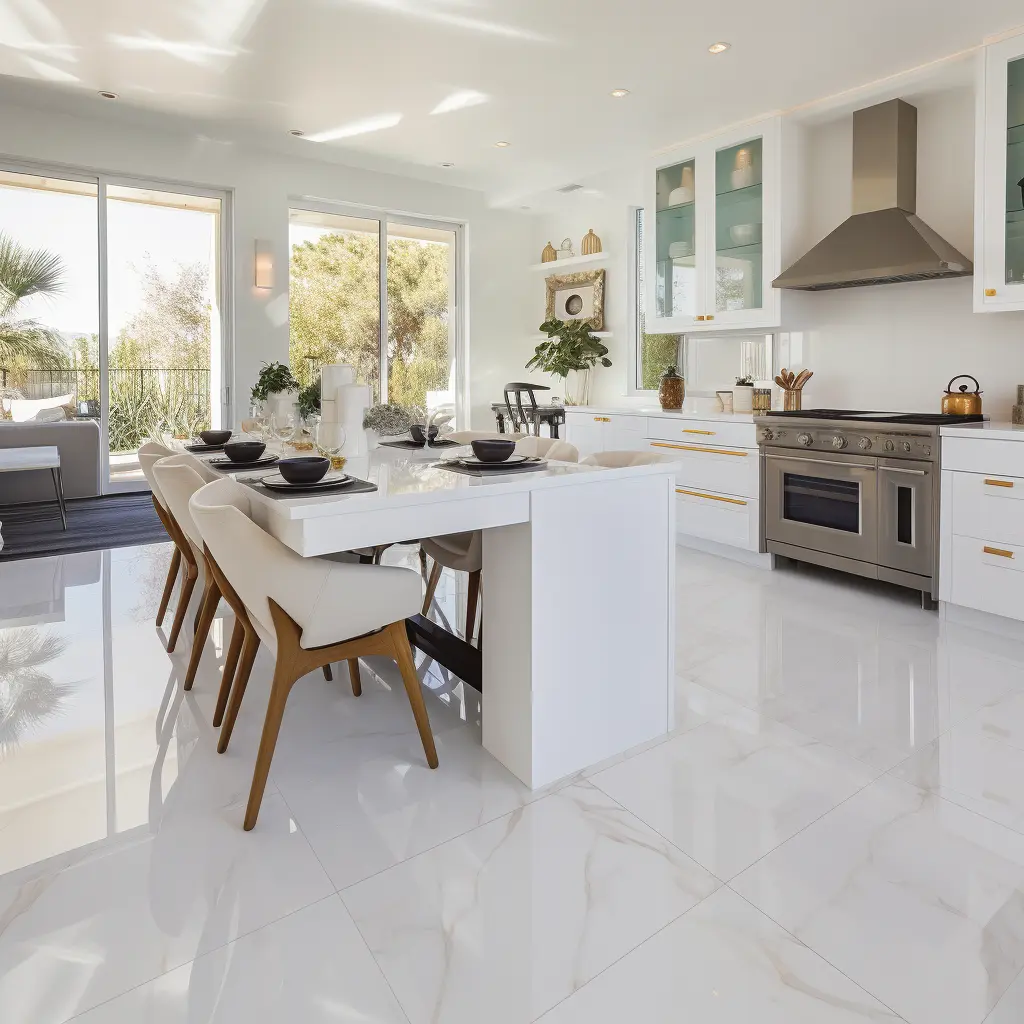
Considerations for Choosing Kitchen Flooring
Before delving into the specifics of different flooring options, it's important to take into account several key considerations that will guide your decision-making process, many of which impact the benefits of an eco-friendly remodel.
1. Lifestyle and Foot Traffic: The kitchen is often the heart of the home, bustling with activity and foot traffic. You’ll want to choose a flooring material that can withstand the demands of your lifestyle. Opt for a durable and easy-to-clean option that can handle spills, stains, and heavy use.
2. Style Sense: Your kitchen flooring should seamlessly blend with the overall design theme of your space. Consider the existing color palette, cabinetry, and countertops to ensure a harmonious aesthetic. Whether you prefer a modern, rustic, or traditional look, there is a flooring option that can complement your style. For more information on eco-friendly kitchen styles that look good, check out our article.
3. Comfort: Kitchens are notorious for requiring long periods of standing, so it's crucial to prioritize comfort. Even if you only cook occasionally or for major holidays, people tend hang out in the kitchen, so you’ll want it to be comfortable to stand on for long periods. Look for flooring materials that offer cushioning and support, such as cork or vinyl, to reduce fatigue and strain on your feet and legs.
4. Ease of Cleaning: Kitchens are prone to spills, splatters, and messes, making ease of cleaning a top priority. Opt for flooring that is water-resistant and stain-resistant, allowing you to effortlessly wipe away any spills or stains without leaving lasting damage.
5. Budget: Renovations often come with a budget, and flooring expenses can vary significantly. Consider your overall renovation budget and allocate a portion to your kitchen flooring. Remember to strike a balance between quality and affordability to ensure a long-lasting and visually appealing result.
Popular Kitchen Flooring Options
Now that we've covered the essential considerations, let's explore some of the most popular kitchen flooring options in more detail:
1. Vinyl Flooring: Vinyl flooring is a versatile and cost-effective option that offers a wide range of design possibilities. It is available in both tile and sheet form, allowing you to choose the option that best suits your kitchen's style. Vinyl flooring is known for its durability, water resistance, and ease of maintenance. It can mimic the look of other materials, such as hardwood or stone, while providing a more budget-friendly alternative.
2. Porcelain Tile Flooring: Porcelain tile is a highly durable and water-resistant option, making it ideal for kitchens. It is available in various designs, including glazed and through-bodied tiles. Glazed tiles offer a vast array of design options, including the ability to mimic the look of natural stone. Through-bodied tiles, on the other hand, are more durable and suitable for high-traffic areas.
3. Hardwood Flooring: Hardwood flooring adds warmth, elegance, and timeless beauty to any kitchen. While it may not be the most water-resistant option, it can still be a viable choice if properly maintained. Consider using engineered wood planks, which are more resistant to moisture, in kitchens to minimize the risk of damage. Hardwood flooring can be refinished multiple times, allowing you to refresh its appearance and extend its lifespan.
4. Cork Flooring: Cork flooring is an eco-friendly option that offers both comfort and sustainability. It is naturally moisture-resistant, making it suitable for kitchens. Cork has natural cushioning properties, providing a comfortable surface to stand on for extended periods. It is also a renewable resource, as the cork oak tree bark can be harvested without harming the tree. However, it requires regular maintenance to prevent damage from spills and scratches.
5. Linoleum Flooring: Linoleum is a green and sustainable flooring option made from natural materials such as linseed oil, cork powder, and wood flour. It is resilient, durable, and available in a wide range of design choices. Linoleum is naturally stain-resistant and easy to clean, making it a practical choice for kitchens. With proper care and maintenance, linoleum flooring can last for decades.
6. Limestone Flooring: Limestone flooring offers a unique blend of old-world charm and natural beauty. It is a sedimentary rock that exudes elegance and sophistication. Limestone is known for its durability and can withstand heavy foot traffic. However, it requires regular sealing and maintenance to prevent staining and damage. Limestone flooring is compatible with various kitchen design styles, adding a touch of timeless beauty to your space.
7. Bamboo Flooring: Bamboo flooring is a sustainable and durable option that offers natural beauty and exotic elegance. Made from the fast-growing bamboo plant, it is an environmentally friendly choice. With its strength and resistance to heavy foot traffic, bamboo flooring is suitable for busy kitchens. It comes in a range of colors and has a distinctive grain pattern, adding warmth and visual appeal. Bamboo flooring is naturally resistant to moisture and relatively easy to maintain. Its sustainability, durability, and design versatility make it a popular choice for eco-conscious homeowners looking for a visually stunning flooring option for their kitchen.
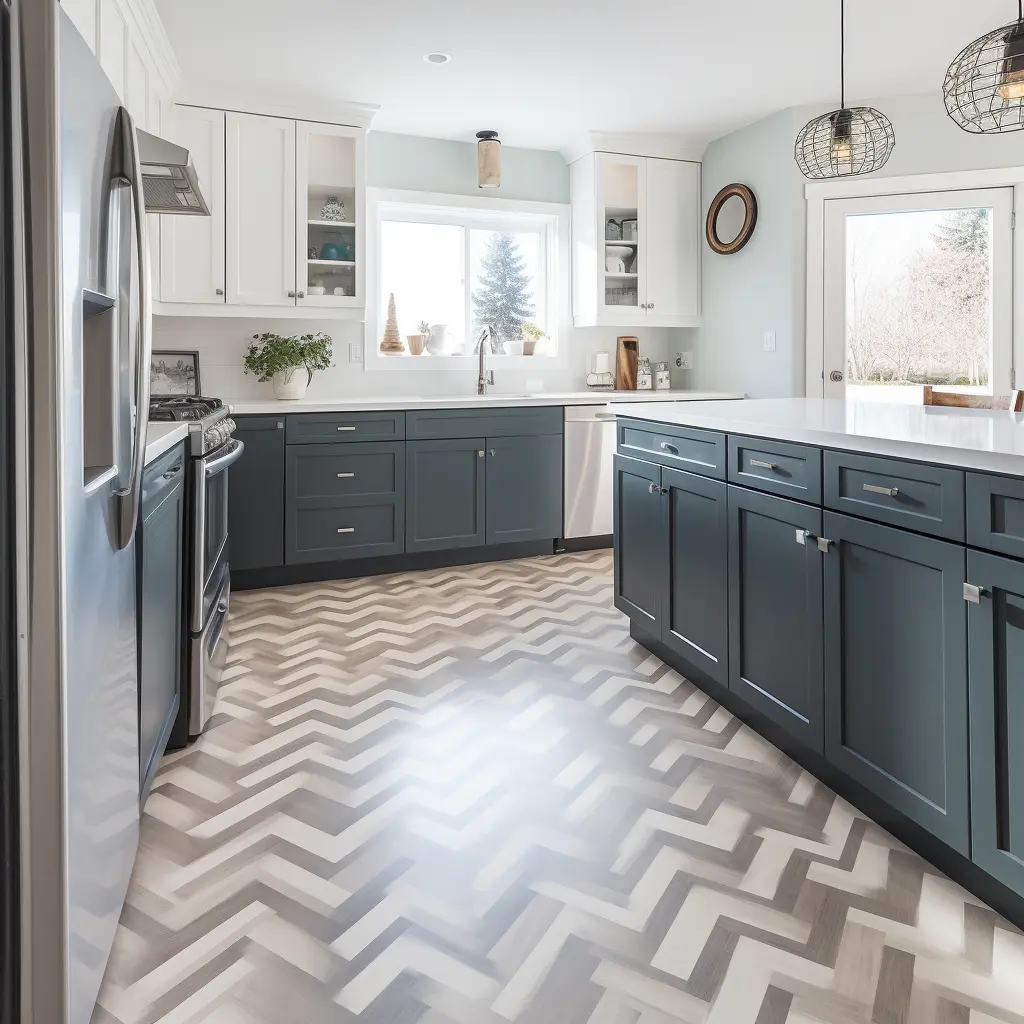
Vinyl Flooring
Vinyl flooring is a popular choice for kitchens due to its affordability, durability, and wide range of design options. It is a versatile flooring material that can mimic the look of other materials, such as hardwood or stone, while providing a more budget-friendly alternative. Vinyl flooring is available in both tile and sheet form, allowing you to choose the option that best suits your kitchen's style.
Features and Benefits: Vinyl flooring is highly durable and resistant to stains, scratches, and water damage. It is easy to clean and maintain, making it an excellent choice for busy kitchens. Vinyl flooring also offers excellent sound absorption, reducing noise levels in your kitchen. Additionally, it provides a comfortable surface to walk on, thanks to its cushioning properties.
Vinyl Tile vs. Sheet Vinyl: Vinyl flooring is available in two main forms: vinyl tile and sheet vinyl. Vinyl tiles are individual pieces that can be arranged in various patterns, allowing for creative design possibilities. Sheet vinyl, on the other hand, comes in large rolls that can be cut to fit the dimensions of your kitchen. Both options offer durability and water resistance, but vinyl tiles provide more design flexibility.
Affordability and Design Options: Vinyl flooring is known for its affordability, making it an attractive choice for homeowners on a budget. It offers a wide range of design options, including different colors, patterns, and textures. Whether you prefer a classic, contemporary, or bold look, there is a vinyl flooring design that can suit your style and enhance the overall aesthetic of your kitchen.
In conclusion, vinyl flooring is a versatile and cost-effective option for kitchen flooring. Its durability, water resistance, ease of maintenance, and wide range of design options make it a popular choice among homeowners. Whether you opt for vinyl tile or sheet vinyl, this flooring option can provide a practical and visually appealing solution for your kitchen.
Services Offered by EcoHome:
- Get Instant Estimates: Our calculators provide accurate construction cost estimates, helping you set realistic expectations for your project budget.
- Hire Vetted Contractors: Post your project on EcoHome and receive a personalized shortlist of vetted contractors. Connect only with the professionals you choose, ensuring a reliable and trustworthy team for your renovation.
- Renovate with Confidence: Embark on your renovation journey with confidence, guided by our tools and resources. From planning to completion, EcoHome provides the support and knowledge you need to navigate the renovation process successfully.
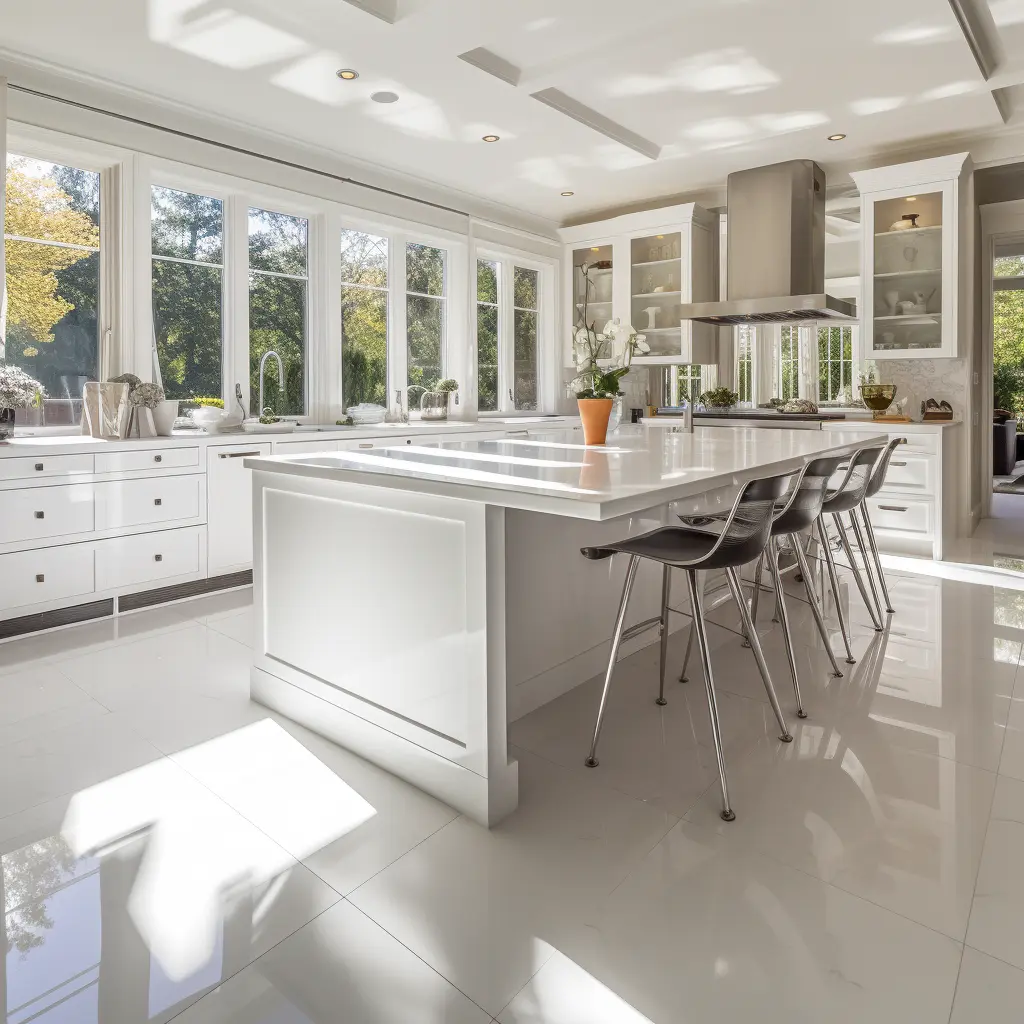
Porcelain Tile Flooring
Porcelain tile flooring is a highly durable and water-resistant option that is well-suited for kitchens. It offers exceptional strength and longevity, making it a popular choice among homeowners. Porcelain tiles are made from dense clay that is fired at high temperatures, resulting in a hard and durable material.
Durability and Water Resistance: Porcelain tiles are known for their exceptional durability, making them resistant to scratches, stains, and wear. They can withstand heavy foot traffic and are highly resistant to moisture, making them ideal for kitchens where spills and water exposure are common. Porcelain tiles are also resistant to temperature changes, making them suitable for kitchens with underfloor heating systems.
Glazed vs. Through-Bodied Tiles: Porcelain tiles come in two main types: glazed and through-bodied. Glazed tiles have a protective layer of liquid glass applied to the surface, giving them a glossy finish and enhancing their resistance to stains and scratches. Through-bodied tiles, on the other hand, have consistent color and texture throughout the entire tile, making them more durable and suitable for high-traffic areas. Both options offer excellent durability and water resistance, so the choice depends on your preferred aesthetic and level of durability required.
Design Versatility and Natural Stone Mimicry: Porcelain tiles offer a wide range of design possibilities, allowing you to achieve various looks in your kitchen. They can mimic the appearance of natural stone, such as marble or slate, without the high cost and maintenance associated with natural stone. Porcelain tiles come in different sizes, shapes, colors, and patterns, giving you the flexibility to create a unique and personalized kitchen floor design.
Porcelain tile flooring is an excellent choice for kitchens due to its exceptional durability, water resistance, and design versatility. Whether you prefer a glossy glazed tile or a through-bodied tile with a natural stone look, porcelain tiles can provide a long-lasting and visually appealing flooring solution for your kitchen.
Hardwood Flooring
Hardwood flooring is a timeless and elegant option that adds warmth and beauty to any kitchen. It is a popular choice among homeowners who appreciate the natural charm and character of wood. Hardwood flooring is available in various species, each with its unique grain patterns and colors.
Warmth and Beauty of Hardwood: Hardwood flooring creates a warm and inviting atmosphere in the kitchen, making it a popular choice for those seeking a cozy and traditional aesthetic. The natural beauty of wood adds a touch of elegance and sophistication to the space, enhancing the overall design.
Considerations for Kitchen Use: While hardwood flooring is a popular choice for kitchens, there are some considerations to keep in mind. Wood is susceptible to moisture, so it's important to choose a hardwood species that is more resistant to water damage. Additionally, it's crucial to promptly clean up any spills or standing water to prevent damage to the wood. Regular maintenance, such as refinishing and resealing, is necessary to keep hardwood flooring in optimal condition.
Solid Wood vs. Engineered Wood Planks: When it comes to hardwood flooring, you have the option of choosing between solid wood and engineered wood planks. Solid wood flooring is made from a single piece of wood and offers the ability to be sanded and refinished multiple times, allowing you to refresh its appearance and extend its lifespan. Engineered wood planks, on the other hand, are made from multiple layers of wood veneer and plywood, providing enhanced stability and resistance to moisture. Engineered wood is a popular choice for kitchens as it is less prone to warping and shrinking due to changes in humidity.
In conclusion, hardwood flooring brings warmth, beauty, and timeless appeal to any kitchen. While it requires proper maintenance and consideration for kitchen use, the elegance and natural charm of hardwood make it a popular choice among homeowners seeking a classic and inviting kitchen space.
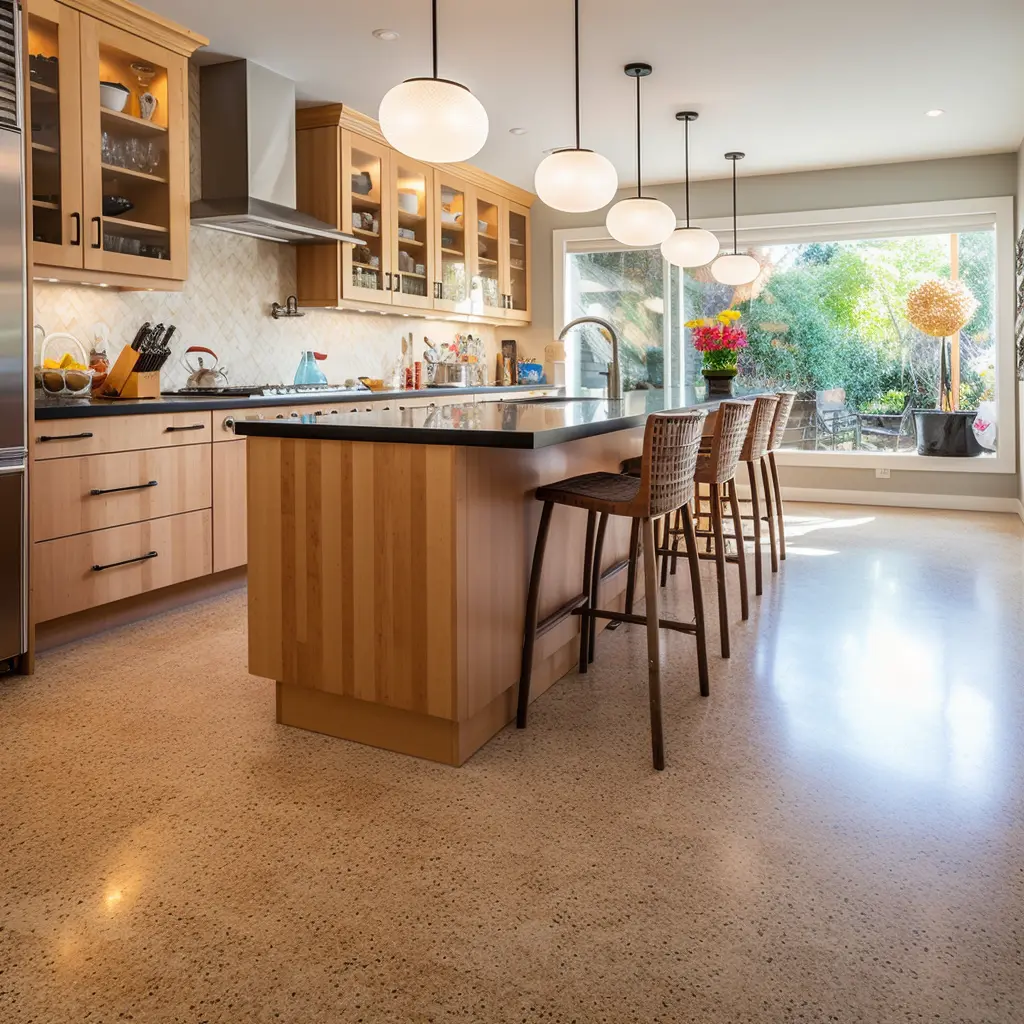
Cork Flooring
Cork flooring is an eco-friendly and sustainable option that offers both comfort and durability. It is made from the bark of the cork oak tree, which can be harvested without harming the tree. Cork flooring has gained popularity in recent years due to its unique properties and environmental benefits.
Eco-Friendly and Moisture-Resistant: Cork is a renewable resource, making it an excellent choice for environmentally conscious homeowners. The bark of the cork oak tree regenerates, allowing for sustainable harvesting. Cork flooring is naturally resistant to moisture, making it suitable for kitchens where spills and humidity are common. It acts as a natural barrier against water, preventing damage and the growth of mold and mildew.
Comfort and Slip Resistance: One of the standout features of cork flooring is its natural cushioning and shock-absorbing properties. This makes it a comfortable surface to stand on for extended periods, making it ideal for kitchens where cooking and meal preparation often involve long hours on your feet. Additionally, cork flooring provides excellent slip resistance, reducing the risk of accidents in the kitchen.
Maintenance Requirements: Cork flooring is relatively low-maintenance, requiring regular sweeping or vacuuming to remove dirt and debris. It is recommended to clean spills promptly to prevent staining. Cork flooring should be sealed with a protective finish to enhance its durability and resistance to moisture. It's important to note that heavy furniture or appliances should have protective pads to prevent indentations on the cork surface.
In summary, cork flooring is an eco-friendly and comfortable option for kitchen flooring. Its moisture resistance, cushioning properties, and slip resistance make it a practical choice for homeowners seeking a sustainable and comfortable kitchen environment.
Linoleum Flooring
Linoleum flooring is a green and sustainable option that has been used for decades. It is made from natural materials such as linseed oil, cork powder, and wood flour, making it an environmentally friendly choice for your kitchen. Linoleum flooring offers a range of benefits, including resilience, durability, and design versatility.
Green and Sustainable Option: Linoleum is made from renewable and biodegradable materials, making it an eco-friendly choice for homeowners who prioritize sustainability. It is manufactured using a low-energy production process, further reducing its environmental impact. Linoleum flooring is free from harmful chemicals and volatile organic compounds (VOCs), contributing to better indoor air quality.
Resilience and Design Choices: Linoleum flooring is known for its resilience and durability, making it suitable for high-traffic areas such as kitchens. It can withstand the demands of a busy kitchen, including spills, stains, and heavy foot traffic. Linoleum is available in a wide range of colors, patterns, and designs, allowing you to create a unique and personalized kitchen floor. Whether you prefer a classic checkerboard pattern or a bold and vibrant design, linoleum offers endless possibilities.
Stain Resistance and Maintenance Tips: Linoleum flooring is naturally resistant to stains, making it easy to clean and maintain. Regular sweeping or vacuuming, along with occasional damp mopping, is usually sufficient to keep linoleum floors looking their best. It's important to avoid using harsh chemicals or abrasive cleaners, as they can damage the surface. Applying a protective sealant can enhance the durability and longevity of linoleum flooring.
In conclusion, linoleum flooring is a green and sustainable option that offers resilience, durability, and design versatility. Its eco-friendly nature, stain resistance, and low-maintenance requirements make it a practical choice for kitchens.
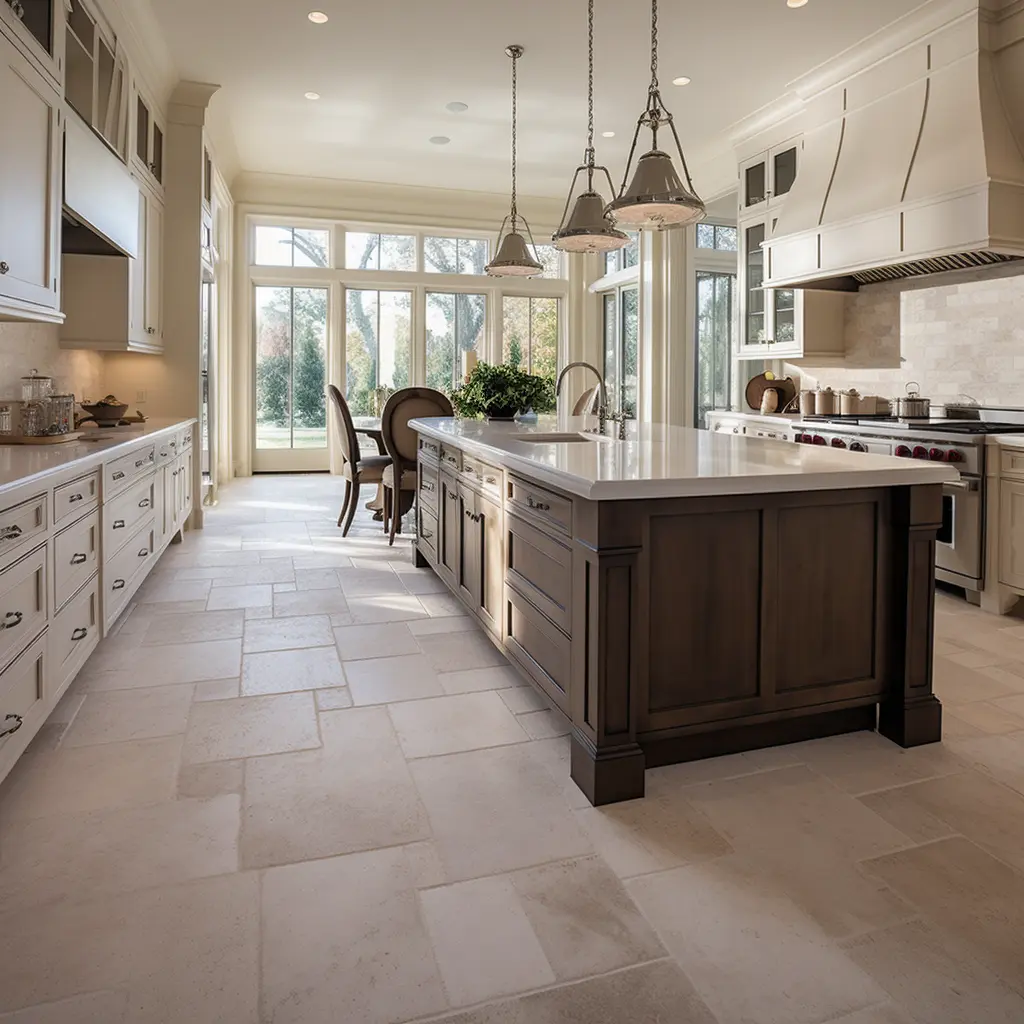
Limestone Flooring
Limestone flooring offers a unique blend of old-world charm and natural beauty, making it a popular choice for homeowners seeking a distinctive and elegant kitchen floor. Limestone is a sedimentary rock formed from the accumulation of marine fossils and minerals over millions of years. Its natural variations in color and texture add character and a touch of sophistication to any kitchen.
Old World Charm and Natural Beauty: Limestone flooring exudes a timeless appeal that can transform your kitchen into a space reminiscent of a European villa or a rustic farmhouse. Its natural beauty lies in the unique patterns, veining, and color variations that are inherent in the stone. From warm earth tones to cool grays, limestone offers a wide range of options to suit different design styles.
Sealing and Maintenance Considerations: Limestone is a porous material, which means it requires proper sealing to protect it from stains and moisture. Sealing the surface helps prevent liquids from penetrating the stone and causing damage. It's important to follow the manufacturer's recommendations for sealing frequency and use appropriate cleaning products to maintain the integrity of the seal. Regular sweeping and damp mopping are usually sufficient to keep limestone floors clean and free from debris.
Compatibility with Kitchen Design Styles: Limestone flooring complements various kitchen design styles, adding a touch of elegance and natural beauty. Whether you have a traditional, Mediterranean, or contemporary kitchen, limestone can enhance the overall aesthetic. Its versatility allows it to be paired with different cabinetry, countertops, and backsplash materials, creating a cohesive and visually appealing space.
Durability and Longevity: Limestone is a durable material that can withstand the demands of a busy kitchen. However, it's important to note that it is softer than some other natural stones, such as granite or quartzite. While limestone is less prone to cracking or chipping, it may be more susceptible to scratches and etching. Taking proper care and using cutting boards and trivets can help minimize the risk of damage and maintain the beauty of your limestone flooring.
In summary, limestone flooring offers a unique combination of old-world charm, natural beauty, and durability. Its compatibility with various kitchen design styles and the ability to create a timeless and elegant atmosphere make it a sought-after choice for homeowners looking to make a statement with their kitchen flooring.
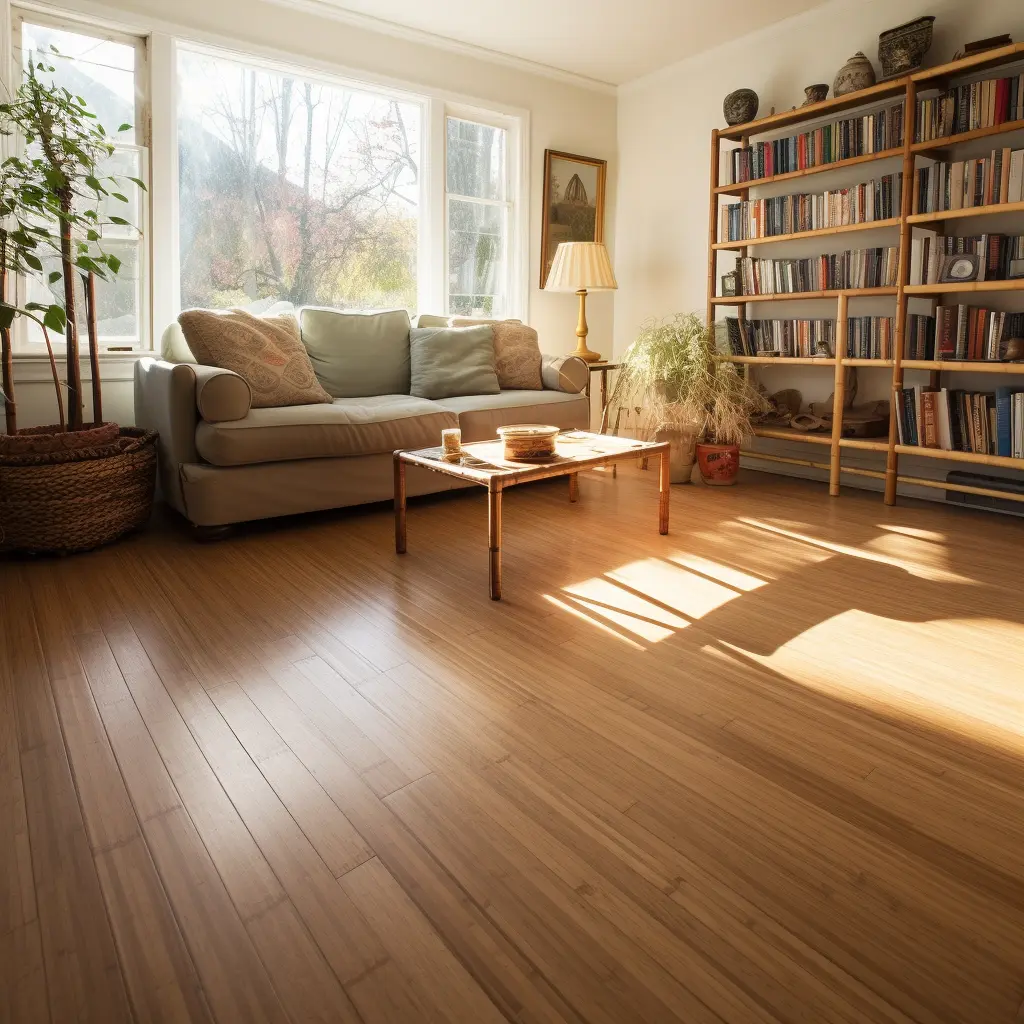
Bamboo Flooring
Bamboo flooring is a sustainable and eco-friendly option that has gained popularity in recent years. It offers a unique blend of durability, natural beauty, and a touch of exotic elegance. Bamboo is a fast-growing grass that can be harvested without harming the plant, making it an environmentally friendly choice for your kitchen flooring.
Sustainability and Eco-Friendliness: Bamboo is considered one of the most sustainable flooring materials available. It is a renewable resource that grows much faster than traditional hardwood trees. Bamboo can reach maturity in as little as three to five years, compared to the several decades it takes for hardwood trees to grow. Choosing bamboo flooring helps reduce deforestation and promotes a greener and more sustainable environment.
Durability and Strength: Despite its grass-like appearance, bamboo flooring is incredibly durable and strong. It has a higher tensile strength than many traditional hardwoods, making it resistant to dents and scratches. Bamboo flooring can withstand the demands of a busy kitchen, including heavy foot traffic and the occasional dropped utensil or pot.
Natural Beauty and Exotic Appeal: Bamboo flooring offers a unique aesthetic that adds a touch of exotic elegance to your kitchen. It features a distinctive grain pattern and a range of natural colors, from light blondes to deeper amber hues. The natural variations in color and texture create a visually appealing and warm ambiance in your kitchen.
Moisture Resistance and Stability: Bamboo flooring is naturally resistant to moisture, making it suitable for kitchens where spills and humidity are common. However, it's important to note that excessive moisture exposure can still cause damage, so it's essential to clean up spills promptly. Proper installation and sealing can enhance the moisture resistance of bamboo flooring.
Maintenance and Care: Bamboo flooring is relatively easy to maintain. Regular sweeping or vacuuming, along with occasional damp mopping, is usually sufficient to keep it clean and free from debris. It's important to avoid using harsh chemicals or abrasive cleaners that can damage the surface. Applying a protective finish can help prolong the lifespan of your bamboo flooring and enhance its resistance to wear and tear.
Design Versatility: Bamboo flooring offers a wide range of design options to suit different kitchen styles and preferences. It is available in various plank sizes, colors, and finishes, allowing you to achieve the desired look for your kitchen. Whether you prefer a modern, rustic, or traditional aesthetic, there is a bamboo flooring option that can complement your design vision.
Bamboo flooring is a sustainable, durable, and visually appealing option for your kitchen. Its eco-friendly nature, strength, natural beauty, and design versatility make it a popular choice among homeowners seeking a unique and environmentally conscious flooring solution.
Conclusion
Choosing the best flooring for your kitchen is a significant decision that requires careful consideration. By taking into account factors such as durability, style, comfort, ease of cleaning, and budget, you can make an informed choice that suits your needs and preferences. Whether you opt for vinyl, porcelain tile, hardwood, cork, linoleum, or limestone, each flooring option has its own unique features and benefits. Remember, a well-chosen kitchen floor not only enhances the functionality of your space but also adds to its overall aesthetic appeal. So, take your time, explore your options, and create a kitchen floor that you'll love for years to come.
In addition to the flooring options discussed, there are other alternatives worth considering for your kitchen. These include bamboo flooring, concrete flooring, and rubber flooring.
Concrete Flooring: Concrete flooring has gained popularity in recent years due to its industrial and modern appeal. It offers durability, easy maintenance, and a sleek, minimalist look. Concrete can be stained, polished, or stamped to create different textures and designs. It is a versatile option that can be customized to fit your kitchen's style.
Rubber Flooring: Rubber flooring is a resilient and comfortable option that provides excellent shock absorption and slip resistance. It is a popular choice for commercial kitchens but can also be used in residential kitchens. Rubber flooring is available in various colors and patterns, allowing you to create a vibrant and visually appealing kitchen floor.
When making your final decision, it's important to consider not only the aesthetics and functionality of the flooring but also its impact on the environment. Opting for eco-friendly and sustainable materials can contribute to a greener and more sustainable home.
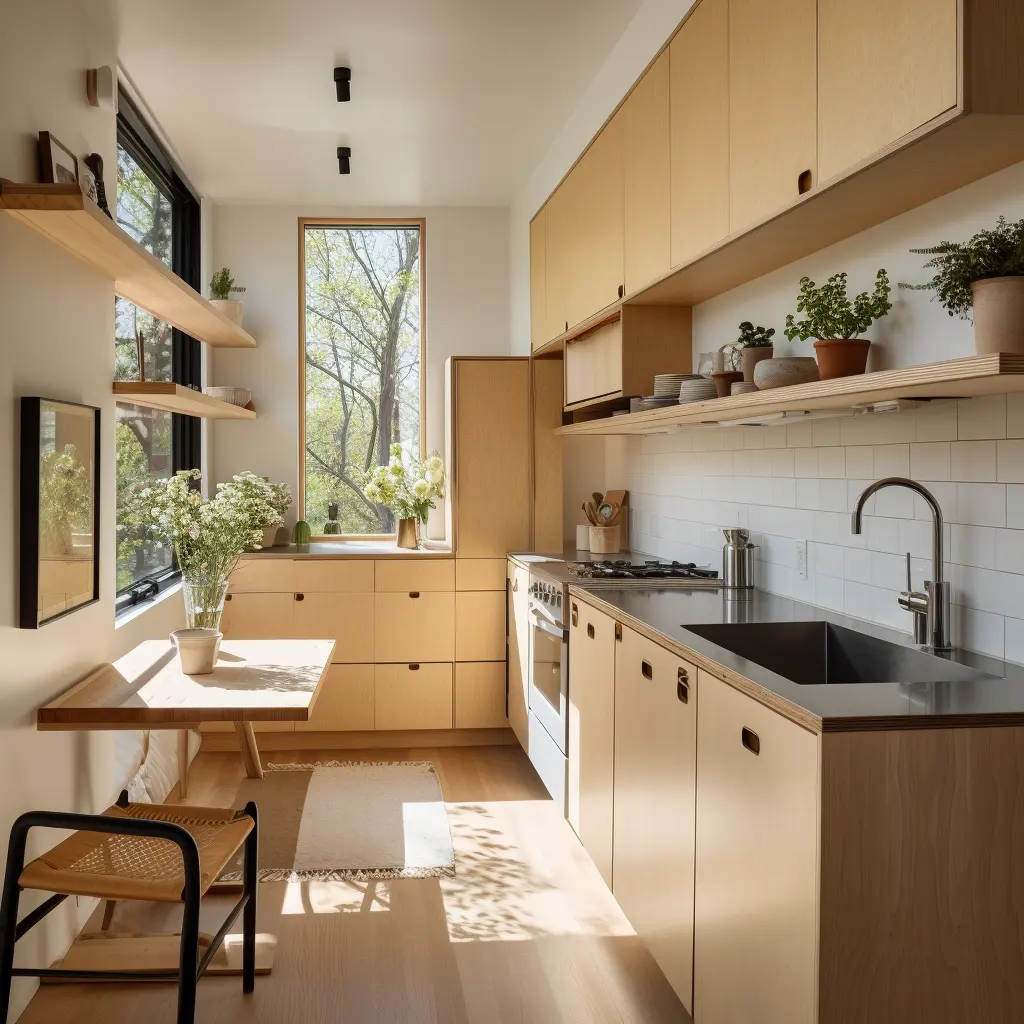
Renovate with EcoHome
EcoHome empowers homeowners to confidently build healthy and comfortable homes for a fair price.
Sign UpLocations View All →
NY
- Albany
- Binghamton
- Buffalo
- Esopus
- Freeport
- Hempstead
- Highland
- Kingston
- Long Beach
- Marlboro
- Mount Vernon
- New Paltz
- New Rochelle
- New York City
- Niagara Falls
- North Tonawanda
- Olivebridge
- Plattekill
- Rochester
- Rome
- Saugerties
- Schenectady
- Shandaken
- Syracuse
- Troy
- Utica
- Valley Stream
- Wallkill
- Woodstock
- Yonkers
NJ
- Bayonne
- Brick
- Camden
- Cherry Hill
- Clifton
- East Orange
- Edison
- Elizabeth
- Jersey City
- Lakewood
- Middletown
- Newark
- Old Bridge
- Passaic
- Paterson
- Toms River
- Trenton
- Union City
- Woodbridge
CT
PA
- Allentown
- Altoona
- Bethel Park
- Bethlehem
- Chester
- Easton
- Harrisburg
- Hazleton
- Lancaster
- Lebanon
- Monroeville
- Philadelphia
- Pittsburgh
- Reading
- Scranton
- Wayne
- Wilkes Barre
MD
- Abingdon
- Baltimore
- Bethesda
- Bowie
- Columbia
- Dundalk
- Ellicott City
- Frederick
- Gaithersburg
- Germantown
- Glen Burnie
- Potomac
- Rockville
- Severn
- Silver Spring
- Towson
- Waldorf



